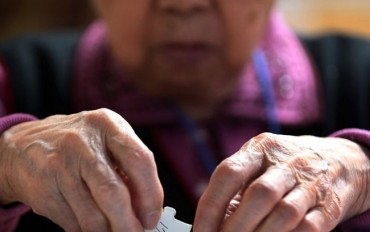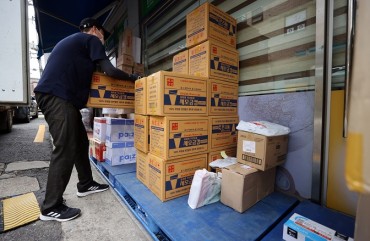
Soldiers repair damage caused by Typhoon Mitag in Chogok, a village in Samcheok, Gangwon Province. (Yonhap)
SEOUL, Aug. 15 (Korea Bizwire) — South Korea’s population on the government’s database of residents register rose slightly and became older in 2019 from a year before, data showed Saturday.
The country reported a total increase of 23,902, or 0.05 percent, in population to 51.8 million, and its average age rose to 42.6 from 42.1, according to the annual national data released by the Ministry of the Interior and Safety.
The statistics, drawn up as of Dec. 31, 2019, and titled “2020 Statistics on Administration and Safety,” cover eight categories — administration, electronic government, provincial administration, provincial finance, safety policy and disaster management.
The average age of women was 43.8, higher than men’s 41.5.
The city of Sejong was the youngest among the country’s administrative districts, with the average age of its residents 36.9, while South Jeolla Province was found to be the oldest with 46.2.
People who were born in 1971 took up the largest portion of the country’s population, with 941,096.
Human density was highest in the capital Seoul at 62.21 square meters per person, while Gangwon Province was lowest at 10,947.30 square meters per person.
The country saw its civil servants record a year-on-year increase of 2.8 percent to 1.1 million, of which female servants took up 47.3 percent, up by 0.6 percentage point.
The statistics showed the year 2019 experienced more financial damage incurred by natural and social disasters compared to the preceding year.
Natural disasters, including typhoons and torrential rains, damaged houses and infrastructure worth 216 billion won, and it cost the country more than 1.3 trillion won to repair the damage.
The damage and recovery costs jumped by 53 percent and 204 percent, respectively, from a year ago.
Nearly 1.3 trillion won, or 98 percent of the total repair costs, was spent on typhoon-related recovery efforts.
A total of 27 “social hazards,” such as fires, maritime accidents and livestock infectious diseases, occurred last year, up from seven in 2018.
Of the cases, fires at crowded buildings accounted for the largest part with 10, followed by wildfires at six and maritime accidents at three.
The total damage from such disasters cost the country more than 520 billion won, 5.2 times that of the previous year.
Last year, the government declared special disaster zones on three occasions — for wildfires in Gangwon Province in April, Typhoon Lingling in September and Typhoon Mitag in October.
The designated areas received the government’s emergency relief and financial aid for recovery.
(Yonhap)






